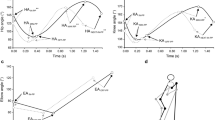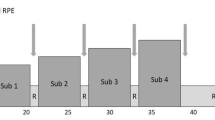Summary
Eight well trained marathon skaters performed all-out exercise tests during speed skating on ice and roller skating. To compare these skating activities in relation to the concept of training specificity, relevant physiological (V O2,V E, RER and heart rate) and biomechanical variables (derived from film and video analysis) were measured. There were no significant differences between oxygen uptake (50.5±8.0 and 53.3±6.7 ml·min−1·kg−1), ventilation (102.4±11.2 and 116.0±11.1 l·min−1) or heart rate (174±12.2 and 176±14.5 min−1) between speed and roller skating. In roller skating a higher RER (1.16±0.1 cf. 1.05±0.1) was found. Power, work per stroke and stroke frequency were equal. Due to a higher coefficient of friction the maximal roller skating speed was lower. The effectiveness of push-off and parameters concerning the skating techniques showed no differences. In roller skating a 7.5% higher angle of the upper leg in the gliding phase occurred. It is speculated that the blood flow through the extensor muscles might be higher in roller skating. It is concluded that roller skating can be considered as a specific training method which may be used by trained speed skaters in the summer period.
Similar content being viewed by others
References
Astrand PO, Rodahl K (1986) Textbook of work physiology, third edition. McGraw-Hill, New York
Barcroft H, Swan HJC (1953) Sympathetic control of human blood vessels. Edward Arnold Publ Ltd, London
Boer RW de, Schermerhorn P, Gademan J, de Groot G, Ingen Schenau GJ van (1986) Characteristics in stroke mechanics of elite and trained male speed skaters. Int J Sport Biomech 2:176–186
Boer RW de, Ettema GJ, Faessen B, Krekels H, Hollander AP, de Groot G, Ingen Schenau GJ van (1987) Specific characteristics of speed skating: implications for a summer training. Med Sci Sports Exerc (in press)
Caiozzo VJ, Perrine JJ, Edgerton VR (1981) Training induced alterations of the in vivo force velocity relationship of human muscle. J Appl Physiol 51:750–754
Daub WD, Green HJ, Houston ME, Thomson JA, Fraser IG, Ranney DA (1983) Specificity of physiological adaptations resulting from ice-hockey training. Med Sci Sports Exerc 15:290–294
Dempster WT (1955) Space requirements of the seated operator. Wright-Patterson Air Force Base, Ohio (WADCTR 55-159)
Durnin JVGA, Rahaman MM (1967) The assessment of the amount of fat in the human body from measurements of skin-fold thickness. Br J Nutr 21:681–689
Duchateau J, Hainaut K (1984) Isometric or dynamic training: differential effects on mechanical properties of a human muscle. J Appl Physiol 56:296–301
Gollnick PD, Piehl K, Saltin B (1974) Selective glycogen depletion pattern in human muscle fibers after exercise of varying intensity and at varying pedalling rates. J Physiol 241:45–57
Green HJ (1978) Glycogen depletion pattern during continuous and intermittent ice skating. Med Sci Sports Exerc 10:183–187
de Groot G, Schreurs AW, Ingen Schenau GJ van (1983) A portable lightweight Douglas bag instrument for use during various types of exercise. Int J Sports Med 4:132–134
Holum D (1984) The complete handbook of speed skating. Enslow Publ Inc, Hillside, USA
Huber G, Siegfried I, Berg A, Keul J (1983) The response of circulating lactate and glucose levels in roller skating during competetive performances in comparision to the same parameters measured ergometrically in a longitudinal study over 4 years. Int J Sport Med 4:57–58
Ingen Schenau GJ van (1982) The influence of air friction in speed skating. J Biomechanics 15:449–458
Ingen Schenau GJ van, de Groot G, Boer RW de (1985) The control of speed in elite female speed skaters. J Biomech 18:91–96
Ingen Schenau GJ van, Boer RW de, de Groot G (1987) Biomechanics of speed skating. In: Vaughan VCL (ed) Biomechanics of sport. CRC Press, Florida (in press)
Kandou TWA, Houtman ILD, Bol E van de, Boer RW de, de Groot G, Ingen Schenau GJ van (1987) Comparison of physiology and biomechanics of speed skating with cycling and with skateboard exercise. Can J Sport Sci 12:31–37
Kanehasi H, Miyashita M (1983) Specificity of velocity in strength training. Eur J Appl Physiol 52:104–106
Kaneko M, Fuchimoto T, Toji H, Suei K (1983) Training effect of different loads on the force-velocity relationship and mechanical power output in human muscle. Scand J Sports Sci 5:50–55
Kobayashi T (1973) Studies of the properties of the ice in speed skating rinks. Ashrae J 15:51–56
Lees A (1980) An optimised film analysis method based on finite difference technique. J Hum Movmt Stud 6:165–180
Lesmes GR, Costill DL, Coyle EF, Fink WJ (1978) Muscle strength and power changes during maximal isokinetic training. Med Sci Sports Exerc 10:266–269
Lier A (1975) Fraskyvsstrukturen i hurtiglop pa skoyter. Norgesidrettshogskole, NH-NORA Oslo 37
Pechar GS, McArdle WD, Katch FI, Magel JR, Deluca J (1974) Specificity of cardiorespiratory adaptation to bicycle and treadmill training. J Appl Physiol 42:753–756
Pollock ML, Foster C, Anholm J, Hare J, Farrell P, Maksud M, Jackson AS (1982) Body composition of Olympic speed skating candidates. Res Quart 53:150–155
di Prampero PE, Cortili G, Mognoni P, Saibene F (1979) Equation of motion of a cyclist. J Appl Physiol 47:201–206
di Prampero PE, Cortile G, Mognoni P, Saibene F (1976) Energy cost of speed skating and efficiency of work against air resistance. J Appl Physiol 40:584–591
Stromme SB, Ingjer F, Meen HD (1977) Assessment of maximal aerobic power in specificially trained athletes. J Appl Physiol 42:833–837
Schulze B, Grossmann G (1983) Der Rollhockeysport aus der Sicht der Sportmedizin. Med Sport 23:190–194
Verstappen FTJ, Huppertz RM, Snoeckx LHEH (1982) Effect of training specificity on maximal treadmill and bicycle exercise. Int J Sports Med 3:43–46
Wilmore JH (1984) The assessment of and variation in aerobic power in world class athletes as related to specific sports. Am J Sports Med 12:120–127
Winter DA (1979) Biomechanics of human movement. Wiley, New York
Author information
Authors and Affiliations
Rights and permissions
About this article
Cite this article
de Boer, R.W., Vos, E., Hutter, W. et al. Physiological and biomechanical comparison of roller skating and speed skating on ice. Europ. J. Appl. Physiol. 56, 562–569 (1987). https://doi.org/10.1007/BF00635371
Accepted:
Issue Date:
DOI: https://doi.org/10.1007/BF00635371




